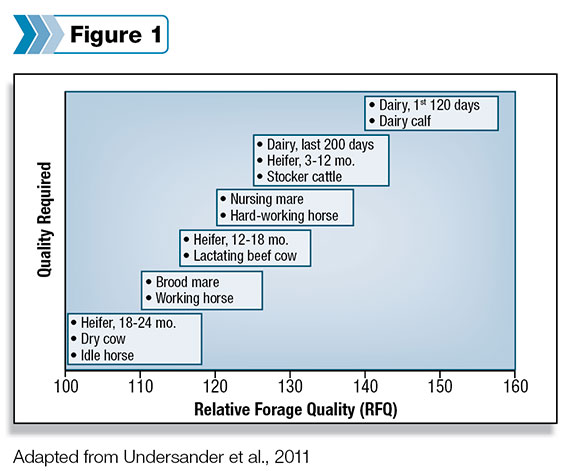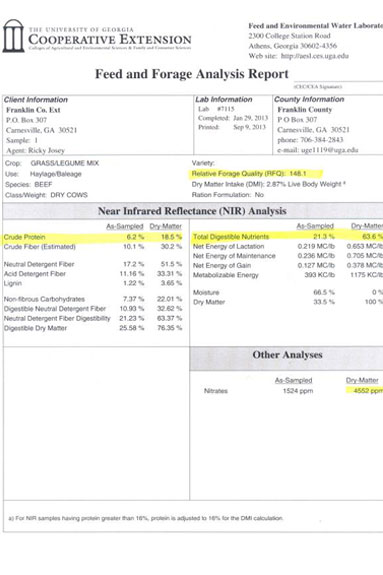We can get some indication of forage quality through visual observation. The presences or absences of seed heads, color, odor and leafiness can be visual indicators of quality, but a hay test is the only method to know for sure the nutritional content.
A forage report can be rather intimidating with its many numbers and terminology. To make things simpler, focus on the values in the “dry matter” column. Using dry matter basis allows comparing several hay samples on equal footing.

The first number that you should consider is the relative forage quality (RFQ). RFQ is based on digestible energy and dry matter intake. It is also the best way to compare several hay lots on equal footing, regardless of forage species.
The RFQ index has a reference point of 100, which is equivalent to full-bloom alfalfa. Ranges of RFQ value are used to indicate which classes of livestock a particular hay lot could be used to satisfy the nutritional needs.
Using Figure 1, you can see that an RFQ of 105 would satisfy the requirements of a dry brood cow but would need to be supplemented in order to meet those of a lactating cow.
Another important number on the forage test is the total digestible nutrient (TDN). TDN is a common measure of energy in feeds.
The energy needs of cattle vary with stage of production, size and expected performance, and is more likely than protein to be deficient in forage-based diets. A TDN of 57 to 58 percent would likely satisfy the energy requirements of lactating beef cattle.

Traditionally, crude protein has been looked at as the most important indicator of hay quality. Crude protein is an important nutrient; however, the requirements by most classes of livestock are typically easy to meet.
Most of our forages, when fertilized according to soil sample recommendations, should give us adequate crude protein.
Another consideration is that crude protein does not tell anything about the form of nitrogen. Nitrogen in crude protein can be bound and unavailable, or it can be in harmful nitrates.
Crude protein also tells very little about the energy content of forage. Dry cows need only about 8 percent crude protein, while those lactating require 12 to 13 percent.
I believe the reason protein has been used so much to compare hay quality is because it traditionally is one of the most expensive nutrients to purchase.
It’s the first thing we look at when reading a feed tag, and we pay the most for the bag containing the highest protein.
Crude protein of forages is important, but animals are going to eat to meet their energy needs, which comes back to how much can and will be eaten and how digestible it is.
Nitrate levels are also given on a forage analysis in parts per million (PPM). We have all heard horror stories of cattle deaths due to high-nitrate hay. However, other losses from nitrate include lowered milk production, abortions and breeding problems.
The publication "Nitrate Toxicity" goes into more detail on nitrates and how to safely feed forages with various levels of nitrates. Nitrate levels of 5,000 PPM are considered safe for beef cattle.
Yes, there is a lot of information on a forage analysis, but that shouldn’t keep producers from utilizing this important tool.
Visual observation can only give an indication of hay quality, but only sending in a well-taken sample can tell you the nutritional content. Then you can use the information to balance the requirements of your livestock efficiently and safely.
If you need more information on this or other forage topics, check out the Georgia Forages website or ask your county extension agent for assistance. The TV commercials for AT&T might say it best … it’s not complicated. FG









